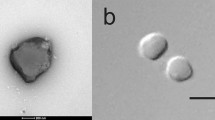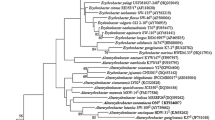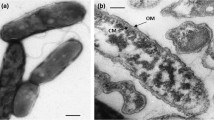Abstract
A novel strictly anaerobic thermophilic heterotrophic bacterium, strain SLHLJ1T, was isolated from a Pacific hydrothermal sediment. Cells were Gram-negative coccobacilli (approximately 1.0 × 0.6 μm) with a toga. It grew at temperatures between 33 and 78 °C (optimum 70 °C). Elemental sulphur and l-cystine stimulated its growth. It contained C16:0, C16:1 ω11c, C18:0 and C18:1 ω9c as major fatty acids (>5 %), 3 phospholipids and 2 glycolipids as polar lipids. Its DNA G+C content was 43.7 mol%. Phylogenetic analyses based on 16S rRNA gene sequences placed strain SLHLJ1T within the family Thermotogaceae. The novel isolate was most closely related to Kosmotoga arenicorallina (97.93 % 16S rRNA gene sequence similarity), K. olearia (92.43 %) and K. shengliensis (92.17 %). On the basis of phenotypic, chemotaxonomic and phylogenetic comparisons with its closest relatives, we propose its assignment to a novel species of the genus Kosmotoga. The name Kosmotoga pacifica sp. nov. is proposed with strain SLHLJ1T (=DSM 26965T = JCM 19180T = UBOCC 3254T) as the type species.


Similar content being viewed by others
References
Alain K, Querellou J, Lesongeur F, Pignet P, Crassous P, Raguénès G, Cueff V, Cambon-Bonavita M-A (2002) Caminibacter hydrogeniphilus gen. nov., sp. nov., a novel thermophilic, hydrogen-oxidizing bacterium isolated from an East Pacific Rise hydrothermal vent. Int J Syst Evol Microbiol 52:1317–1323
Altschul S, Gish W, Miller W, Myers E, Lipman D (1990) Basic local alignment search tool. J Mol Biol 215:403–410
Ben Hania W, Ghodbane R, Postec A, Brochier-Armanet C, Hamdi M, Fardeau ML, Ollivier B (2011) Cultivation of the first mesophilic representative (“mesotoga”) within the order Thermotogales. Syst Appl Microbiol 34:581–585
Ben Hania W, Ghodbane R, Postec A, Hamdi M, Ollivier B, Fardeau ML (2012) Defluviitoga tunisiensis gen. nov., sp. nov., a thermophilic bacterium isolated from a mesothermic and anaerobic whey digester. Int J Syst Evol Microbiol 62:1377–1382
Ben Hania W, Postec A, Aüllo T, Ranchou-Peyruse A, Erauso G, Brochier-Armanet C, Hamdi M, Ollivier B, Saint-Laurent S, Magot M, Fardeau ML (2013) Mesotoga infera sp. nov., a mesophilic member of the order Thermotogales, isolated from an underground gas storage aquifer. Int J Syst Evol Microbiol 63:3003–3008
Bligh E, Dyer W (1959) A rapid method of total lipid extraction and purification. Can J Biochem Physiol 37:911–917
Cord-Ruwisch R (1985) A quick method for the determination of dissolved and precipitated sulfides in cultures of sulfate-reducing bacteria. J Microbiol Methods 4:33–36
Davey ME, Wood WA, Key R, Nakamura K, Stahl D (1993) Isolation of three species of Geotoga and Petrotoga: two new genera, representing a new lineage in the bacterial line of descent distantly related to the “Thermotogales”. Syst Appl Microbiol 16:191–200
De Ley J, Cattoir H, Reynaerts A (1970) The quantitative measurement of DNA hybridization from renaturation rates. Eur J Biochem 12:133–142
DiPippo JL, Nesbø CL, Dahle H, Doolittle WF, Birkland NK, Noll KM (2009) Kosmotoga olearia gen. nov., sp. nov., a thermophilic, anaerobic heterotroph isolated from an oil production fluid. Int J Syst Evol Microbiol 59:2991–3000
Felsenstein J (1981) Evolutionary trees from DNA sequences: a maximum likelihood approach. J Mol Evol 17:368–376
Felsenstein J (1985) Confidence limits on phylogenies: an approach using the bootstrap. Evol 30:783–791
Feng Y, Cheng L, Zhang X, Li X, Deng Y, Zhang H (2010) Thermococcoides shengliensis gen. nov representing a novel genus of the order Thermotogales from oil-production fluid. Int J Syst Evol Microbiol 60:932–937
Gillis M, Vandamme P, De Vos P, Swings J, Kersters K (2001) Polyphasic taxonomy. In: Boone DR, Castenholz RW, Garrity GM (eds) Bergey’s manual of systematic bacteriology, vol 1, 2nd edn., The Archaea and the deeply branching and phototrophic BacteriaSpringer, New York, pp 43–48
Gouy M, Guindon S, Gascuel O (2010) SeaView version 4: a multiplatform graphical user interface for sequence alignment and phylogenetic tree building. Mol Biol Evol 27:221–224
Huber R, Langworthy TA, König H, Thomm M, Woese CR, Sleytr UB, Stetter KO (1986) Thermotoga maritima sp. nov. represents a new genus of unique extremely thermophilic eubacteria growing up to 90 °C. Arch Microbiol 144:324–333
Huber R, Woese CR, Langworthy TA, Fricke H, Stetter KO (1989) Thermosipho africanus gen. nov., represents a new genus of thermophilic eubacteria within the “Thermotogales”. Syst Appl Microbiol 12:32–37
Huss VAR, Festl H, Schleifer KH (1983) Studies on the spectrophotometric determination of DNA hybridization from renaturation rates. Syst Appl Microbiol 4:184–192
Jayasinghearachchi HS, Lal B (2011) Oceanotoga teriensis gen. nov., sp. nov., a thermophilic bacterium isolated from offshore oil-producing wells. Int J Syst Evol Microbiol 61:554–560
Kämpfer P, Kroppenstedt RM (1996) Numerical analysis of fatty acid patterns of coryneform bacteria and related taxa. Can J Microbiol 42:989–1005
Kim OS, Cho YJ, Lee K, Yoon SH, Kim M, Na H, Park SC, Jeon YS, Lee JH, Yi H, Won S, Chun J (2012) Introducing EzTaxon-e: a prokaryotic 16S rRNA Gene sequence database with phylotypes that represent uncultured species. Int J Syst Evol Microbiol 62:716–721
Larkin MA, Blackshields G, Brown NP, Chenna R, McGettigan PA, McWilliam H, Valentin F, Wallace IM, Wilm A, Lopez R, Thompson JD, Gibson TJ, Higgins DG (2007) Clustal W and Clustal X version 2.0. Bioinformatics 23:2947–2948
Ludwig W, Strunk O, Klugbauer S, Klugbauer N, Weizenegger M, Neumaier J, Bachleitner M, Schleifer KH (1998) Bacterial phylogeny based on comparative sequence analysis. Electrophoresis 19:554–568
Mesbah M, Premachandran U, Whitman WB (1989) Precise measurement of the G+C content of deoxyribonucleic acid by high-performance liquid chromatography. Int J Syst Bacteriol 39:159–167
Nesbø CL, Bradnan DM, Adebusuyi A, Dlutek M, Petrus AK, Foght J, Doolittle WF, Noll KM (2012) Mesotoga prima gen. nov., sp. nov., the first described mesophilic species of the Thermotogales. Extremophiles 16:387–393
Nunoura T, Hirai M, Imachi H, Miyazaki M, Makita H, Hirayama H, Furushima Y, Yamamoto H, Takai K (2010) Kosmotoga arenicorallina sp. nov. a thermophilic and obligately anaerobic heterotroph isolated from a shallow hydrothermal system occurring within a coral reef, southern part of the Yaeyama Archipelago, Japan, reclassification of Thermococcoides shengliensis as Kosmotoga shengliensis comb. nov., and emended description of the genus Kosmotoga. Arch Microbiol 192:811–819
Patel BKC, Morgan HW, Daniel RM (1985) Fervidobacterium nodosum gen. nov. and spec. nov., a new chemoorganotrophic, caldoactive, anaerobic bacterium. Arch Microbiol 141:63–69
Reysenbach AL (2001) Phylum BII. Thermotogae phy. nov. In: Boone DR, Castenholz RW (eds) Bergey’s manual of systematic bacteriology. Springer, Berlin, pp 369–387
Saitou N, Nei M (1987) The neighbour-joining method: a new method for reconstructing phylogenetic trees. Mol Biol Evol 4:406–425
Tindall B (1990a) A comparative study of the lipid composition of Halobacterium saccharovorum from various sources. Syst Appl Microbiol 13:128–130
Tindall B (1990b) Lipid composition of Halobacterium lacusprofundi. FEMS Microbiol Lett 66:199–202
Tindall B, Sikorski J, Smibert RA, Krieg NR (2007) Phenotypic characterization and the principles of comparative systematics. In: Reddy CA, Beveridge TJ, Breznak JA, Marzluf G, Schmidt TM, Snyder LR (eds) Methods for general and molecular microbiology, 3rd edn. ASM Press, Washington DC, pp 330–393
Wery N, Lesongeur F, Pignet P, Derennes V, Cambon-Bonavita MA, Godfroy A, Barbier G (2001) Marinitoga camini gen. nov., sp. nov., a rod-shaped bacterium belonging to the order Thermotogales, isolated from a deep-sea hydrothermal vent. Int J Syst Evol Microbiol 51:495–504
Zeng X, Birrien JL, Fouquet Y, Cherkashov G, Jebbar M, Querellou J, Oger P, Cambon-Bonavita MA, Xiao X, Prieur D (2009) Pyrococcus CH1, an obligate piezophilic hyperthermophile: extending the upper pressure-temperature limits for life. The ISME J 3:873–876
Acknowledgments
We acknowledge Dr. J.P. Euzéby for support in the Latin etymology of the species name and anonymous reviewers for constructive comments. The Joint Research Unit UMR 6197 (CNRS-Ifremer-UBO), EU program KBBE.2012.3.2-02: Improved cultivation efficiency of marine microorganisms MaCuMBA (Marine Microorganisms: Cultivation Methods for Improving their Biotechnological Applications), a partenariat Hubert Curien PHC XU GUANGQI collaboration grant n° 27941TL by Egide to MJ, International Sci & Tech Cooperation Program of China (2010DFB23320), National Program on Key Basic Research Project (973 Program, No. 2012CB417300), National Natural Science Foundation of China (No. 41106150) and COMRA project (No. DY125-15-R-01) supported analyses.
Author information
Authors and Affiliations
Corresponding authors
Additional information
Communicated by F. Robb.
S. L’Haridon and L. Jiang contributed equally to this work.
Electronic supplementary material
Below is the link to the electronic supplementary material.
Rights and permissions
About this article
Cite this article
L’Haridon, S., Jiang, L., Alain, K. et al. Kosmotoga pacifica sp. nov., a thermophilic chemoorganoheterotrophic bacterium isolated from an East Pacific hydrothermal sediment. Extremophiles 18, 81–88 (2014). https://doi.org/10.1007/s00792-013-0596-7
Received:
Accepted:
Published:
Issue Date:
DOI: https://doi.org/10.1007/s00792-013-0596-7




